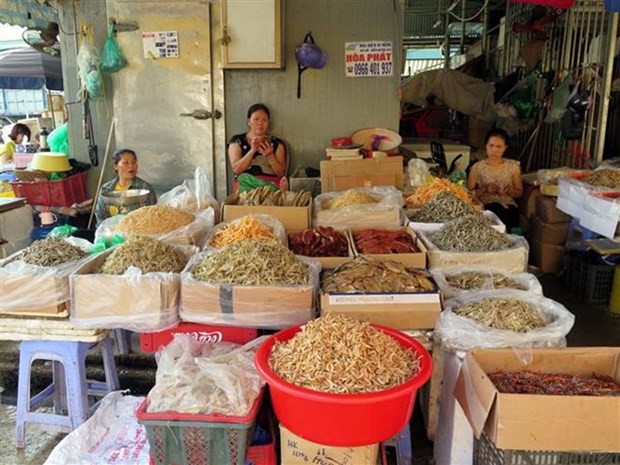Hanoi: Traditional market renovation still face challenges
Hanoi’s Long Bien district began a project to renovate old traditional markets to be more modern in 2016, but only 13 of the 20 existing markets have been upgraded so far.
 A stall in Long Bien market (Source: VNA)
A stall in Long Bien market (Source: VNA) Hanoi (VNS/VNA) - Hanoi’s Long Bien district
began a project to renovate old traditional markets to be more modern in 2016,
but only 13 of the 20 existing markets have been upgraded so far.
The project, initiated by municipal authorities, aims to build or renovate traditional markets across the city into trading centres to meet consumers’ demand as well as hygiene and safety standards.
However, Long Bien, like many other districts, is facing many difficulties in the transition.
Nguyen The Trong, who manages four markets in Long Bien district’s Ngoc Lam ward, told Thoi bao Kinh te Viet Nam (Vietnam Economic Times) that a traditional market needed to meet at least 10 criteria to be recognised as modern and civilised market.
These criteria include infrastructure conditions, fire safety, food safety and hygiene, and public order, he said.
After two years of implementation, 13 out of 20 traditional markets in the district were recognised as modern and civilised, according to Trong.
The remaining markets were still trying to meet requirements, showing that reforming traditional markets was not simple, he said.
Some criteria required time and efforts of both local authorities and traders such as protecting consumers’ interests and traditional cultures, he said.
A representative from Tay Ho district’s Economic Office told the newspaper that infrastructure development was the biggest challenge.
Many markets face infrastructure degradation, requiring time and investment to upgrade, he said.
Meanwhile, many traditional markets have become dilapidated and are below fire prevention, food safety and hygiene standards.
One of biggest traditional wholesale markets in Hoang Mai district, which supplies hundreds of tonnes of vegetables and fruits and 30 tonnes of meat products and seafood each day, is struggling to be recognised as civilised market.
Sanitation conditions at the market are very poor with wastewater stagnant on the floor. Meanwhile, many traders display their products on nylon canvas which lies on the floor, failing to meet food safety and hygiene requirements.
In addition, many markets already recognised as meeting standards have started to retrograde.
Nga Tu So, the 8,000 sq.m market located between Dong Da and Thanh Xuan districts, with nearly 800 stores, has faced many problems in trading due to infrastructure degradation, leading to a fewer customers coming.
Deputy Director of the Hanoi Department of Industry and Trade Tran Thi Phuong Lan warned that many traditional markets in the city were on “red” alert, meaning they failed to meet requirements, particularly in fire safety.
Hanoi has 454 markets but only 22.4 percent of them have proper infrastructure and nearly 30 percent are makeshift.
She suggested municipal authorities to earmark appropriate funds from the city’s budget to build new markets or upgrade traditional ones and call for investment from different social resources in renovating markets and review land funds, with priority given to the construction of markets.
Market management efficiency also needs to be improved to ensure sustainable and effective operation of markets, according to Lan.-VNS/VNA
The project, initiated by municipal authorities, aims to build or renovate traditional markets across the city into trading centres to meet consumers’ demand as well as hygiene and safety standards.
However, Long Bien, like many other districts, is facing many difficulties in the transition.
Nguyen The Trong, who manages four markets in Long Bien district’s Ngoc Lam ward, told Thoi bao Kinh te Viet Nam (Vietnam Economic Times) that a traditional market needed to meet at least 10 criteria to be recognised as modern and civilised market.
These criteria include infrastructure conditions, fire safety, food safety and hygiene, and public order, he said.
After two years of implementation, 13 out of 20 traditional markets in the district were recognised as modern and civilised, according to Trong.
The remaining markets were still trying to meet requirements, showing that reforming traditional markets was not simple, he said.
Some criteria required time and efforts of both local authorities and traders such as protecting consumers’ interests and traditional cultures, he said.
A representative from Tay Ho district’s Economic Office told the newspaper that infrastructure development was the biggest challenge.
Many markets face infrastructure degradation, requiring time and investment to upgrade, he said.
Meanwhile, many traditional markets have become dilapidated and are below fire prevention, food safety and hygiene standards.
One of biggest traditional wholesale markets in Hoang Mai district, which supplies hundreds of tonnes of vegetables and fruits and 30 tonnes of meat products and seafood each day, is struggling to be recognised as civilised market.
Sanitation conditions at the market are very poor with wastewater stagnant on the floor. Meanwhile, many traders display their products on nylon canvas which lies on the floor, failing to meet food safety and hygiene requirements.
In addition, many markets already recognised as meeting standards have started to retrograde.
Nga Tu So, the 8,000 sq.m market located between Dong Da and Thanh Xuan districts, with nearly 800 stores, has faced many problems in trading due to infrastructure degradation, leading to a fewer customers coming.
Deputy Director of the Hanoi Department of Industry and Trade Tran Thi Phuong Lan warned that many traditional markets in the city were on “red” alert, meaning they failed to meet requirements, particularly in fire safety.
Hanoi has 454 markets but only 22.4 percent of them have proper infrastructure and nearly 30 percent are makeshift.
She suggested municipal authorities to earmark appropriate funds from the city’s budget to build new markets or upgrade traditional ones and call for investment from different social resources in renovating markets and review land funds, with priority given to the construction of markets.
Market management efficiency also needs to be improved to ensure sustainable and effective operation of markets, according to Lan.-VNS/VNA













